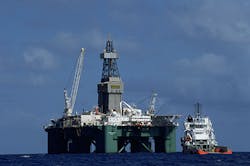Optimizing operational efficiency
UTILIZING TECHNOLOGY TO SURVIVE AN UNCERTAIN OIL MARKET
JIMMY SEBASTIAN, SEVEN LAKES TECHNOLOGIES, WESTLAKE VILLAGE, CA
The days of $120 barrel oil are a distant memory and the industry is still struggling to adjust to a price drop of more than 50%. Some companies have been forced to cut drilling production and others have filed for bankruptcy. Looking back over the oil industry's boom and bust history, however, it is hard to imagine that the drop in prices took anyone completely by surprise.
Many industries have been guilty of overlooking opportunities for operational efficiency when the tide is high and margins are large, but oil and gas extraction should be on the cutting edge in its application of technology, at least on the production side. The companies that can produce at the lowest cost have always been the winners and technologies that create operational efficiencies should not be overlooked as part of that equation.
RECENT HISTORY
Since the mid-1900s, much of the industry's innovative investments were dedicated to offshore drilling. This changed about a decade ago when US companies developed the technology to extract from shale through hydraulic fracturing and horizontal drilling. What was previously considered uneconomic turned attainable through new, less-conventional exploration procedures. The shale boom reached its peak in 2013-2014 and so did the investment in infrastructure that would maximize this new source of production. Generally applied in North America, the shale boom made the US wildly successful and for the first time in 50 years, the US became a net exporter.
Then, almost a year ago, complex geopolitical factors saw oil producers in the Middle East decide to compete with shale by increasing production and collapsing the price of oil. The effect was so severe that even this new, more affordable technology turned cost prohibitive.
Today, oil has dropped below $50/barrel and recent international events like China's devaluation of the yuan and the possible lifting of Iran's sanctions are making everyone wonder how much further prices could fall. The numerous companies in the US that have invested in the shale boom are now struggling to sustain their infrastructure at a much lower price, while costs, overhead, capital expenses, and interest payments have bubbled.
All of this has created a heightened urgency in the industry to use every available tool to squeeze the most out of their margins. The question is not if, but where and how to reduce costs, increase production, and improve efficiency. Companies must take a hard look at one of the few factors within their control-the efficiency of their business operations.
THE OPPORTUNITY
Data from the Gartner 2014 Digital Oil Field (DOF) Survey indicates that upstream companies plan to continue investing in digital field technologies at current or higher levels in pursuit of three business benefits :
- Increasing production/production optimization (top priority for 37% of respondents)
- Improving operational efficiency (top priority for 29% of respondents)
- Cost reductions/savings (top priority for 20% of respondents)
The payoff is turning out to be well worth the investment. In many instances, the cost savings and increased production can add millions to the bottom line. While there are new innovations coming to market constantly, the following are categories where analytics/workflow software are having the greatest results enabling companies to make higher impact decisions.
ANALYTICS FOR DOWNTIME REDUCTION AND PRODUCTION OPTIMIZATION
Oil and gas producers face significant challenges in managing, tracking, reporting, and analyzing well-level profitability, which in turn impacts their ability to optimize their operational performance. This results in higher costs due to greater unplanned maintenance and lost revenue.
Downtime reduction
By performing analysis that captures estimated production loss and downtime, oil and gas companies can generate timely reporting and visibility to identify the root causes of downtime. This empowers companies to determine and prioritize the highest impact wells that should receive immediate attention to minimize loss and get production up and running as quickly as possible. Providing this level of actionable data has saved individual companies as much as $100 million annually.
Production optimization
Production and well profitability analytics help monitor production performance indicators and to identify problems/anomalies and low producing wells quickly. As the work is expansive and all-consuming, well reviews are performed on individual wells once or twice a year. Tailored analytics solutions, which automate the manual work, allow for daily reviews and make decision-making more accessible. Such analytics solutions have been credited with improving performance by 1-2% on an average (Note: Depending on an organization's size, even a 1% improvement results in millions of dollars in revenue).
PROCESS EFFICIENCIES AND DRILLING PROGRAM, WELL DELIVERY ACCELERATION
Well delivery management software automates, integrates, and streamlines numerous pre-drilling tasks and departments (resource development, land, geology, project development, drilling, completions, regulatory, and production) to allow the management of activities on one platform. This software can reduce the lead-time associated with planning and drilling by an average of 5%, allowing companies to begin production and reach targets for their numerous wells several days early.
The impact on improved rig scheduling and utilization alone (where each day can save between $30,000/rig to $100,000/rig) typically generates millions of dollars in annual savings.
ANALYTICS MODULES FOR OPTIMIZING PROJECT AND VENDOR SPEND
Given the size and number of financial transactions, a tremendous amount of loss can be attributed to mismanagement. Frequently, these organizations fail to monitor expenses properly, putting them at risk of overspending.
In one example, a well-known company in upstream oil and gas exploration, and production with a market capital of $18 Billion was growing both organically and through acquisitions. With a recent uptick in E&P activities coupled with ongoing acquisitions, they began losing visibility into their vendor management process. This resulted in an inefficient procurement process, increased maverick spend, prolonged delays in vendor, material, delivery time, and a lack of visibility into key vendor performance metrics. Through process re-engineering and technology/automation the company has generated a 20% reduction in maverick spend.
CONCLUSION
In today's environment, the focus is to do more with less. To survive in this depressed pricing environment, oil and gas companies must:
- Accelerate the transformation of their organizations to be data- and analytics-driven and to adapt to the changing business and technology landscape;
- Consider the low-hanging fruit; the quick-to-implement, low business disruption analytics and process improvement technology solutions; and
- Apply established technology solutions developed specifically for oil and gas in an effort to realize ROI more quickly.
Applied correctly, technologies that bring data to the decision maker will drive better, faster decisions by maximizing assets, tailoring cost reduction, increasing production, and improving efficiency. Imagine how profitable your operations will be when the prices go back toward $120 per barrel.
ABOUT THE AUTHOR
Jimmy Sebastian is Chief Product Officer at Seven Lakes Technologies. He is a technology executive with over 15 years of experience in product management and consulting with a focus on business intelligence and analytics, business process management, supply chain management and product development. Sebastian has held management positions at Ticketmaster, Spirent, UST Global and jda. He holds a bachelor's degree in engineering from IIT Madras and an MBA from IIM Calcutta.
1Gartner, Top 10 Technology Trends Impacting the Upstream Oil and Gas Industry in 2015, Morgan Eldred, Rich McAvey, Leif Eriksen, 18 March 2015


